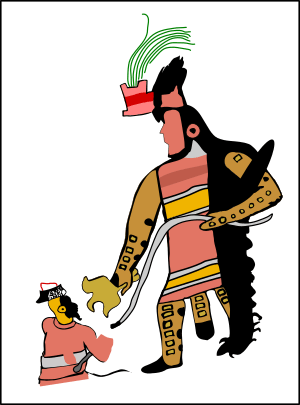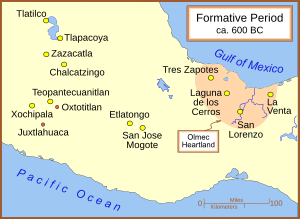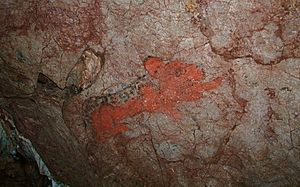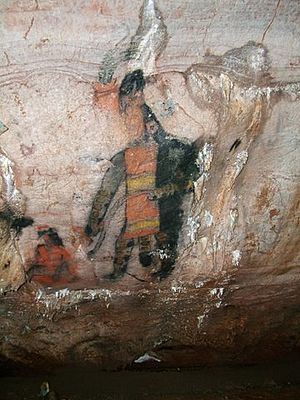Juxtlahuaca facts for kids
Juxtlahuaca (say "hoosh-tlah-WAH-kah") is a special cave and archaeological site in the Mexican state of Guerrero. It's famous for its amazing murals, which are large paintings on walls. These paintings are linked to the ancient Olmec people and their unique art style.
Along with another nearby cave called Oxtotitlán, Juxtlahuaca has some of the oldest and most detailed cave paintings ever found in Mesoamerica. Mesoamerica is a historical region that includes parts of Mexico and Central America. These caves are also the only known examples of deep cave art in Mesoamerica that were not made by the Maya people.
The Juxtlahuaca Cave
The Juxtlahuaca cave is about 45 kilometers (28 miles) southeast of Chilpancingo, the capital city of Guerrero. Today, the cave is part of a National Park. The entire cave system is a bit longer than 5 kilometers (3 miles).
These caves are also known as Grutas de Juxtlahuaca, which means "Grottos of Juxtlahuaca." They are a popular spot for spelunkers, who are people who explore caves as a hobby. The caves are open to visitors, but you need a local guide to go inside.
The ancient paintings are located deep inside the cavern, more than a kilometer (over half a mile) from the entrance. It takes about two hours to walk down to them. Some parts of the passages might even have water in them.
Amazing Cave Paintings
The most famous artwork in the cave is called Painting 1. It shows a tall man with a beard, wearing a black cloak and a striped shirt. He has a fancy headpiece. His arms and legs are covered in jaguar fur, and you can even see a small jaguar tail hanging down. The man is holding a trident (a three-pronged spear) towards a much smaller person who is crouching beside him. He also carries a long snake or something that looks like a snake.
This painting is about 2 meters (6 feet) tall. It's one of the few Olmec-style pictures that shows one human being powerful over another. Some experts think it might show an important ancient ceremony or ritual.
Another important painting in Juxtlahuaca shows a red Feathered Serpent with green feathers. Nearby, there's a painting of a red jaguar. This jaguar has large ears and eyes, which make it look young. There's also a design on a stalagmite (a rock formation growing up from the cave floor) that looks like a temple.
People have known about these cave paintings since at least the 1920s. However, they were first studied properly in the early 1960s by Gillett Griffin and Carlo T. E. Gay. An archaeologist named Michael D. Coe believes the paintings might be from the Early Preclassic period, which was around 1200-900 BC.
It's interesting because Juxtlahuaca doesn't seem to have been near a large town from that time. Also, no one knows how Olmec-style art ended up being painted hundreds of kilometers (or miles) away from the main Olmec heartland. The Olmec heartland was the central area where the Olmec culture developed. Caves were very important in Olmec art and beliefs. Many Olmec stone carvings show priests or rulers coming out of caves. Other ancient sites, like Chalcatzingo, also have many cave motifs, which are repeated designs or themes.
Other Discoveries in the Cave
In a part of the cave called the Hall of the Dead, about halfway between the entrance and the paintings, twelve skeletons were found. Their positions, some stretched out and some curled up, and their condition (covered with a stalactite crust), suggest they were buried there a very long time ago. Some of the skeletons were partly buried because of a cave-in.
Just before you reach the paintings, there's an artificial canal cut into the red clay floor of the cave. This canal is about 80 meters (250 feet) long. We don't know for sure what this canal was used for.
See also
 In Spanish: Grutas de Juxtlahuaca para niños
In Spanish: Grutas de Juxtlahuaca para niños






